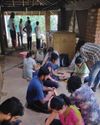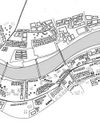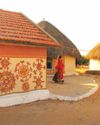‘Resilience’ as defined by physics is, “The ability to store strain energy and deflect elastically under a load without breaking or being deformed.” Practices in Nagaland have been harnessing its existing skill-sets, traditions and materials along with newer systems to adapt and initiate progress within existing challenges in Nagaland. The case of Nagaland is an interesting trajectory to understand design a means to reinforce economic and social resilience in a context specific modus.

Nagaland, as the name suggests, is the native land of the Naga tribe. Their hilly villages sustained on an eco-system of agriculture, foraging and hunting. This system was altered by ‘reforms’ introduced by the British. The Missionaries from America and Europe introduced Christianity and somewhere the traditional Naga practices were deemed ‘pagan’ and hence, wrong. While the British administration brought formal education to Nagaland, the Morung Culture was rendered irrelevant. Fortunately not all was lost. Each tribe had their own distinctive annual festivals and these cultures were revived and preserved because of these festivals. ‘Angamis’ had a peer group system or Youth Institutions called ‘Peli’/’Pelikro’. Here the Village is divided in ‘khels’ and each ‘Khel’ had ‘Pelis’ based on Age group. These ‘Pelis’ actually are groups which carry out all cultural and even institutional and livelihood activities to help preserve the cultural resource of the land.
After independence from the British in 1947, Nagaland became an independent state in 1962, carved from Assam. Therein entered political unrest as further demands for sovereignty emerged. Along the same time, funds from the central government were also misused and the youth began vying for government jobs as a source of easy income. The work culture almost died. This resulted in loss of skills in addition to the damages done by British towards the indigenous traditions. Nagaland’s main resilience challenge lay in the degradation of available resources and skillset which had resulted in infrastructural and economic development. Herein, what can be the role of architecture and design to reinstate a resilient ecosystem in Nagaland?
この記事は Indian Architect & Builder の October 2017 版に掲載されています。
7 日間の Magzter GOLD 無料トライアルを開始して、何千もの厳選されたプレミアム ストーリー、9,000 以上の雑誌や新聞にアクセスしてください。
すでに購読者です ? サインイン
この記事は Indian Architect & Builder の October 2017 版に掲載されています。
7 日間の Magzter GOLD 無料トライアルを開始して、何千もの厳選されたプレミアム ストーリー、9,000 以上の雑誌や新聞にアクセスしてください。
すでに購読者です? サインイン

Interlacing Perspectives
‘Meraki-2019’ A visionary Seminar series presented by Dr.Baliram Hiray College of Architecture, Bandra(East), Mumbai.

Facilitating A Community Through Architectural Practice
The humble, self-designed, self-built and organically planned home built by the majority of the world population rarely gets appreciated and critiqued as a viable lesson in architectural design.

The Art Of Solving Problems Creatively
The practice of architecture is perhaps incomplete without the complement of a variety of other arts.

Upcycling towards a playful tomorrow
Play is like the middle child, often forgotten, and always taking a back seat. For young kids, play can simply be running around, armwrestling with friends, building sandcastles on the beach, or singing popular music tracks in the shower.

Balancing The Poetics And Pragmatism Of Everyday Design
Humanity is faced with an oxymoronic crisis. The crisis involves the earth, the environment, impending looms of climate change, deforestation, loss of species, dwindling resources etc.

Just Give Me Some Space: Discussions And Beyond
Just Give Me Some Space (JGMSS) is Suha Riyaz Khopatkar’s debut book that paints a portrait of the dynamic life of an architecture student.

The Next In Vernacular Architecture
Architecture has become a capitalist.

Rethinking The Future: Architecture And Its Education
“I want to be like animals, the bird makes a nest in one or two days, the rat digs a hole in a night, but intelligent humans like us spend 30 years to have a house, that’s wrong.” - Jon Jandai

Uniting The Human-Scale With The City-Scale
London-based architect Usman Haque is famed for his interactive architectural systems, and for his exploration of newer, more effective ways of creating human engagement and interaction through his designs. Indian Architect & Builder caught up with him, to quiz him on a variety of topics such as his journey as an architect, his inspirations and philosophies, architects using the digital revolution to their advantage, and more!

Framing spaces
Almost every architect also doubles as a photographer or at least an enthusiast.